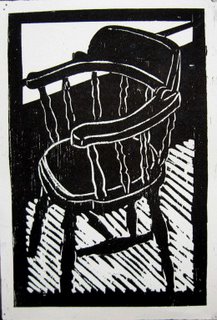Preparing Some Wood

Inside the Studio of a Woodcut Artist



As mentioned in the previous post, my time in NYC included seeing an amazing show with Suzanne at the Met called Glitter and Doom, which was all portrait paintings and drawings from Germany's Weimar years. Over 100 works, about half from Otto Dix, and also cool stuff from George Grosz, Max Beckmann, and several other artists. Up top is a preparatory drawing by Dix for his triptych painting Metropolis. As mounted, the drawing triptych is a monumental 6 feet high and about 10 feet wide, a scale that allows for incredible detail and impact. Unfortunately this show closes on Feb 19, so if you want to see it you better get there soon.
I wouldn't say that Dix and his contemporaries are direct influences, but I've long felt a kinship for these guys. Maybe a decade or so ago I gave some thought to where my art fits in to the history of art, mostly to make it easier to describe to people what my art is like. The most common comparisons that I hear are German Expressionism and Pop Art. These two movements are definitely influences, but I don't think either is a truly accurate classification for what I do. My art is firmly rooted in Modernism, so I started looking through 20th century history. In the end, what I seemed to have the most in common with (especially with my portrait prints) is the movement in 1920's Germany called Neue Sachlichkeit (New Objectivity). My subjects are not the lowlife society fringe that Dix specialized in, but my approach is a kind of psychological realism that is common to the work in this show.
Seeing all these portrait paintings and drawings makes me more excited than ever to start that portrait piece I had been planning, but still lacking a model, that will have to wait.

Lack of recent updates can be attributed to a variety of factors, including work and the Valentine's Day blizzard, but the last few days have been occupied with going up to the city to see some of my fellow SIU grads from the MFA program of the mid 90's. These are all people I've kept in touch with through letters, phone and e-mail, but hadn't seen since I left Carbondale in 1995. However, the CAA was in town this week, and the SIU faculty traditionally organize a little get together, and I knew that some of my old friends (all painters who also did some prints) would be there. So I took the train up early yesterday and met up with Suzanne C. Thomas (Oklahoma) and we headed up to the amazing Glitter and Doom show at the Met. Then a 6 train back downtown to the alumni gathering where I ran into John Lustig (formerly Chicago, now Terre Haute) by the elevator banks, and we all went up together to find Armen Sarrafian (Chicago) and John Siblik (Iowa) and a bathtub full of iced-down beer. Also got to chat with some of the faculty from our time, Ed Shay and Harris Deller, and current grad Diana Baumbach, who remembered me from when she was an undergrad at Wash U and Tom Huck had me out to St Louis (2003) to work on a print and talk to his classes. Later at another event, Siblik introduced me to Sandra Murchison, who I had been in phone/e-mail contact with regarding an exhibition of the School Days group folio at her school in Mississippi a while back. Then the gang headed out for deli and drinking. Other than the food being better and beer a lot more expensive, it was almost like no time had passed, instead of the 12 or 13 years that it has been since I've seen all these people. Had a really great time. Found a place to crash last night, and after stuffing myself at a diner this morning, took the train back home. So what does all this have to do with the Studio?
Well, Studio Arrabbiata has its roots in those Carbondale days, back when the 5 of us all had individual studios just steps away from each other in the Good Luck Glove Factory- not unlike my current location, a space converted to art studios from its previous use. Some semesters you might only meet with your faculty a few times, so interaction with the other grads was very important. The photo above shows the table where I did most of my cutting, including those piles of blocks for the 366 print Fourth of July series. It was there in Glove studio 203E that I evolved my drawing/cutting style and my way of developing ideas. It was there that I started the Everyman series, the latest of which is the St Budoc print that you can see developing throughout the January archives of this blog. Without all those experiences, Studio Arrabbiata might not exist today.


